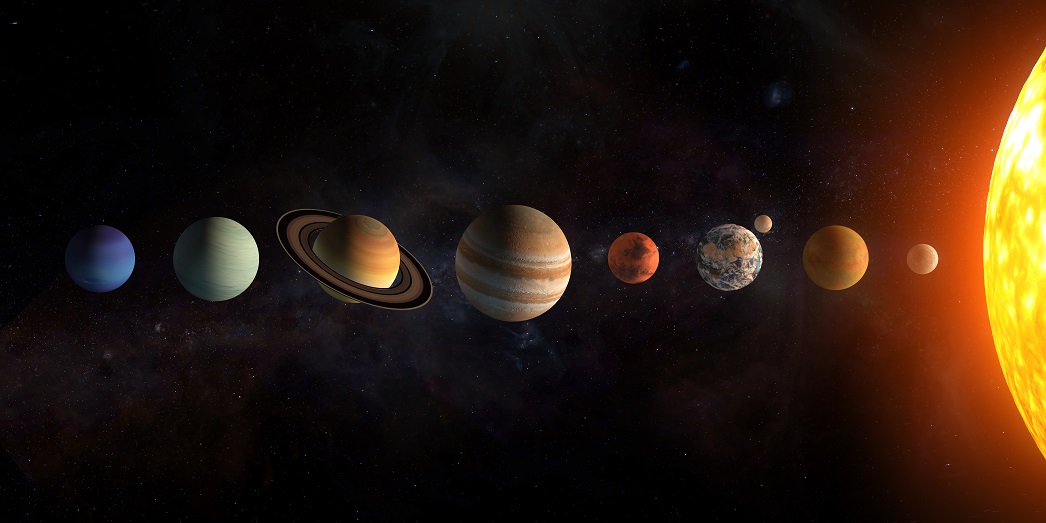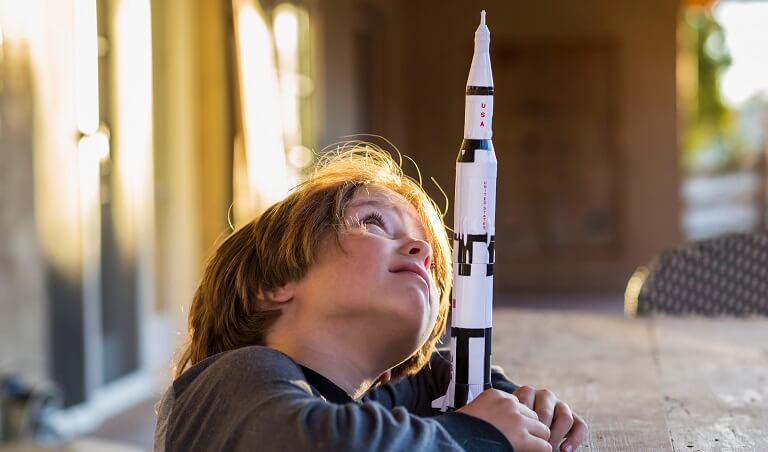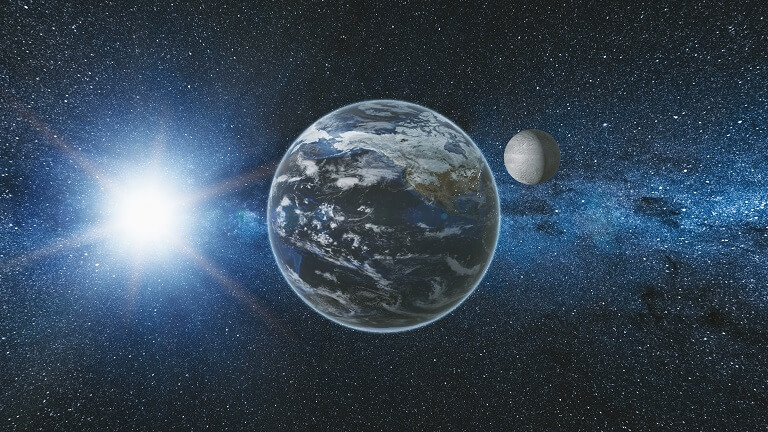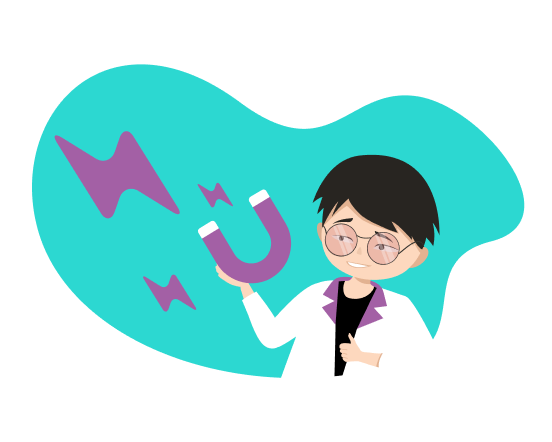
Fun facts about the Solar system for kids
A kid-friendly guide to the basics of astronomy. Essential knowledge about the solar system in thrilling details and breath-taking facts.
One cosmic conversation
Did you know that the Sun is just a star in the Galaxy consisting of millions of stars? And it is not even the biggest star in the Universe! If we could have a cosmic conversation, the Sun would tell us many interesting things!
It would probably tell: “I have many fans on Earth, and they see me much closer than other stars. They think I am the biggest in the Universe. But it is not so, as I am a medium-sized star with a big mass. I am a worthy cosmic body! Just think, eight planets, comets, and asteroids orbit around me! Human puzzle what makes me shine? Here is my secret: I contain helium and hydrogen, producing a lot of energy! That makes my special glow!”. It is pretty awesome, right?
How about diving into the mysterious science of astronomy and finding out more astonishing facts? Let’s get it started!
What is the Solar system?
We can see many cosmic bodies, just looking at the sky with our naked eyes: the Sun, the Moon, stars, and planets. All they belong to our Solar system.
Greek philosophers were the first who have noticed some bright objects that wander around stars. They called them planets or Wandering stars. These planets are closest to us. They orbit around the Sun just like our planet does.
Later the astrophysicists discovered the organization of space bodies in the whole system. Our Solar system’s gravity pulls eight planets, dwarf planets, countless comets, asteroids, and various cosmic objects and makes the whole system. It looks like an egg, and scientists say it has an elliptical form.
The Sun
It is the most significant source of energy and life on our planet. How does it make so much energy? It transforms the hydrogen in its core into helium and explodes an immense amount of energy or radiation.

Some fancy facts about our Sun:
- It always moves.
- It lives in the center of the planetary system.
- Its light reaches Earth for eight minutes.
- It is the biggest body in our planetary system.
- Its temperature is 28,080,000° F (15,600,000° C).
Even though we can fit a 1,3 million size Earth in the Sun, scientists name it a yellow dwarf, as it is a medium-sized star. It is the only star that astronomers can study in detail. However, our Sun is not the one object of astronomy. There is something more outstanding — the Universe.
Sun, Milky Way, and Universe
Let run over the main terms. The Galaxy contains an enormous amount of stars, their planetary systems, and space dust. Galaxy facts:
- Gravity holds all elements of the Galaxy together.
- There are supermassive black holes in their center of many galaxies.
- Our Galaxy has a spiral form. Other galaxies have elliptical or irregular shapes.
Our Solar system is a part of a galaxy called the Milky Way. We can see its stretch across the sky with naked eyes. The whole Universe has billions of galaxies! Since the 1990s, scientists discovered numerous planetary systems with the same properties as our Solar system has. There is a star in their centers and at least several planets orbiting around main stars. These planets are called extrasolar.
Just remember:
- Earth is a part of our planetary (solar) system.
- The Milky Way is our “home galaxy”.
- The Universe contains billions of galaxies.
Birth of our Solar system
The Milky Way gave birth to an outstanding star — our Sun. It happened billions of years ago. Here is what our Sun could tell about its birthday: “My age is about 4,6 billion years. Honestly, I don’t remember the exact day when I appeared in the Universe. Scientists think that I formed from a dense cloud, dust, and interstellar gas”.
Instead of our Solar system, there was a giant interstellar cloud more than 4,6 billion years ago. It was floating in space until its gravitation became unstable because of a nearby exploding star.
The pressure in the cloud’s center was so high that it pulled more and more materials due to gravity. It formed a very dense and hot core. It had a snowball effect. The more bodies the core pulled, the stronger gravity became, pulling much more space bodies. The center of the cloud pulled about 99,9% of materials around the cloud, forming our Sun. Once it became hot and dense enough to trigger a nuclear fusion and the Sun began producing light. 0,1% of materials remained spinning around the Sun. Later they transformed into the planets.
The planets
We can see six planets of our solar system with naked eyes, and all eight of them with binoculars and telescopes. Eight planets come into two types: terrestrial and gaseous planets.
- Terrestrial planets. Four closest to the sun planets. They have solid planetary systems, no rings, and a few or no moons. These planets have atmospheres and weather patterns.
- Gaseous planets. They have many moons and mainly consist of gases and ice. They are giant planets and the second biggest objects in the Solar System.
All planets vary in size, temperature, and constitution:
- Mercury is the most diminutive rocky planet. It lives very close to the Sun, just 35 million miles from it!
- Venus is a solid planet with a cloudy atmosphere. It is the hottest place in the planetary system as its average temperature reaches 460°C.
- Earth has living creatures and always rotates. It takes one day to make a complete rotation.
- Mars looks reddish because of the iron in the rocks, soil, and dust. This planet also has some atmosphere, but not more.
- Jupiter is the giant and record-setter. It is the most extensive planet. It is possible to fit 1321 planets of Earth’s size inside Jupiter. Jupiter has brown and white stripes. These are clouds and long-lasting storms.
- Saturn is the gas planet with rings consisting of chunks of ice and dust.
- Uranus. This planet can not support life due to an atmosphere. It is a giant that is four times larger than Earth. Astronomers could find this planet with the telescope. The only spacecraft flown close to the Uranus is Voyager 2.
- Neptune is the ice giant and the last planet in our planetary system. Its color is blue due to methane absorbing red light and emitting blue one.
To remember the order of the planets, you can create a silly rhyme using the first letters of the planets. The verses may be simple but quite memorable, for example, My Very Excellent Mother Just Served Us Noodles.
Presence of Life on the Planets
As we know, Earth is the only planet with alive creatures. Other known planets are not fit for life. Some of them are too hot, and others are too cold. Finally, there is not enough air.
Some scientists suggest that there may have been alive creatures on Mars many years ago. As they think that Mars earlier was warmer, and there may have been more air. They seek tracks of leaving creations on Mars.

Besides, as the Universe contains billions of galaxies, scientists believe that there may be living somewhere in the Universe. Who knows, maybe some alien kid on the other part of the Universe is studying his planetary system right now. And he may even wonder if there is life in a galaxy far, far away.
Year on Earth and other planets
Did you know that our concept of time is quite subjective? Planets take different amounts of time to orbit the Sun. We call this time a year. One year variously lasts on other planets, and this is extremely interesting!
A year on Earth lasts approximately 365 days. It is the amount of time that Earth needs to travel around the Sun one time. But it is not pretty precise. Earth takes about 365 days and approximately 6 hours to circle the Sun. That is why we have one extra day every four years and call it a leap year.
How long lasts a year on other planets? It depends on where they are orbiting. The closest planets to the Sun orbit around it faster due to the Sun’s gravity, which is much powerful:
Mercury
- Duration of a year on the planet: 88 Earth’s days on;
- Distance from the Sun: 35 million miles.
Venus
- 225 Earth’s days;
- 67 million miles.
Earth
- 365 days;
- 93 million miles.
Mars
- 687 Earth’s days;
- 142 million miles.
Jupiter
- 4333 Earth’s days;
- 484 million miles.
Saturn
- 10 759 Earth’s days;
- 887 million miles.
Uranus
- 30 687 Earth’s days;
- 1,78 billion miles.
Neptune
- 60 190 Earth’s days;
- 2,80 billion miles from the Sun.
Pluto and other Dwarf Planets
The scientists used to call Pluto a planet until 2006. However, they discovered other objects with similar sizes and properties. Then they agreed to name Pluto and similar objects Dwarf planets. They are five official dwarfs: Pluto, Eris, Haumea, Ceres, and Makemake.
Dwarf planets are big bodies, but they do not meet all requirements to be a planet. Planets have three common properties:
- They orbit around the Sun;
- They have enough mass and gravity;
- They have cleared their orbits of other similar objects.
Asteroids
Millions of pieces of metal and rock are called asteroids. Most asteroids live in a certain area that is called the asteroid area. It is located between Mars and Jupiter. The asteroid belt looks like debris that other bodies in the solar system form due to the collision.
We can compare the asteroid belt with a highway in orbits around the Sun. Imagine that asteroids are cars that go on a roadway and run into one another. When they are reaching, they split into more miniature ones.
Even though asteroids live at a great distance from the Sun, they also orbit it. The diameter of the largest asteroids is a hundred miles. Small asteroids regularly reach the atmosphere of Earth. More often, they just burn in the sky.
By the way, you can create your asteroid with simple materials: clay, sand, rocks, marble or metal ball bearing, measuring spoons.
Meteors
Meteors or meteoroids are space rocks that enter the atmosphere of the Earth. When they fall to the Earth, the air resistance makes them very hot, and then we see a Shooting star. However, it is not a rock but glowing hot air. When Earth meets a lot of them, we see meteor showers.
Comets
Comets are chunks of ice and dirt from the outer solar system. Comets have their orbits too. If orbits of the planets have circular shapes, orbits of comets are lop-sided. If a comet comes close to the Sun, its ice starts boiling. As a result, the comet loses many of its parts. By the way, that is how its tail forms. Each year Earth crosses the comet’s orbit, and then our planet faces many comet debris or meteors.
Scientists suggest that a great asteroid or comet may have fallen into our planet 65 million years ago. And it can be a reason why dinosaurs have died. But they also suggest that there was not the only bad day for our planet. Comets and asteroids regularly hammered Earth. As comets consist of water, they might bring much water on Earth and take part in creating an ocean.
Kuiper Belt and Oort Cloud
The Kuiper Belt has some features with an asteroid belt, but The Kuiper Belt is much larger. It is the flat ring of icy objects that orbit the Sun at a great distance. At least three dwarf planets are members of The Kuiper Belt — Makemake and Pluto are among them.
Oort Cloud is a theoretical cloud that can be a home of long-period comets. This cloud contains trillions of comets. Scientists believe that the majority of objects of the cloud are made of ice.
Moons

A satellite in astronomy is a smaller body that moves around the larger body. Gravitation and centripetal forces keep the natural satellites in their orbits. Moon is a rocky ball that orbits Earth. But the Earth is not the only planet with its moon:
- Mars has two moons — Phobos and Deimos. They are little and potato-shaped. Scientists think that they are two captured asteroids. When Romans gave names to the planet and its moons, they thought about the Greek God of War, Ares, and his two horses that pulled his chariot. It is very poetic, right?
- Jupiter, as the largest planet in our system, has 79 known moons.
- Saturn has got 53 moons. Among them is Titan. This moon has its atmosphere, which is very unusual for the moon.
Our Moon is much smaller than Earth. The Moon completes a full orbit for 28 days. Our Moon looks like a desert with mountains and valleys. Its surface has enormous craters that make her rather scary. Some huge space objects bump into the Moon and create these holes. Our Moon facts:
- There is no suitable atmosphere for breathing ;
- The Moon is the second and the only place in the Universe that humans visited.
- Recently scientists discovered water on the bottom of the Moon;
- It travels around the Earth in a shaped orbit;
- Why is our Moon so scarred with craters? The Moon has no atmosphere and weather. That is the reason why all the marks that the Moon has will stay unchangeable. Earth also has tracks of craters, but they are gradually disappearing thanks to the atmosphere.
Exploring the Solar System
To explore the Solar System, scientists use special devices — artificial satellites. The first human-made object that orbited the Earth is Satellite Sputnik 1. The other spacecraft are called Probes with cameras and other tools. The probes traveled Mars, Venus, Titan’s Moon, and asteroids.
Astronomers intensively study Mars. Today the fleet of robotic spacecraft study the martian surface. The next-generation rover landed on Mars on the 18th of February in 2021. Rovers Perseverance, Curiosity, and stationary lander Insight are working at the surface. NASA also has three spacecraft to explore the orbit.
Gravity
Gravity is the main force that holds people on Earth’s surface and does not let them fly into space. Thanks to this force, we can jump without floating away. Gravity is the Universe’s attraction. It is an invisible pulling power. Every object has its gravity. There are two main properties of gravity:
- More massive space bodies have stronger gravity;
- The gravitational pull between objects will be stronger if they are near enough to each other.
- The Sun has the strongest gravity, as it has the biggest mass. The Sun pulls Earth and other planets orbiting around it. However, not every cosmic body orbits around the Sun. For example, the Moon is a satellite of the Earth. Earth always orbits the Sun on the same trajectory, and it looks a bit like an oval. The scientists call it an orbit.
Interesting facts about the Solar system for kids
- Everything is moving all the time, even you do! Even when you just stay in one place, you are flying through space incredibly fast! Earth is carrying us like a spaceship. It orbits the Sun moving 67 000 miles per hour. The Sun moves around the center of our Galaxy. Our Galaxy moves around too, like everything in our Universe.
- We can not see Neptune without a special spacecraft. Mathematicians predicted the existence of Neptune before its discovery in 1846. It is so distant from the Sun, that Neptune’s noon looks like a dim twilight on Earth.
- Life on Mars. Scientists think that this planet has a watery past as its minerals and rocks could have only formed in liquid water. Even today, Mars has some water, but it can exist long due to the thin atmosphere. Romans called it for their God of war, Ares, as its red color was reminiscent of blood.
- Proxima Centauri is a star that is close enough to Earth. It is smaller, colder than our Sun. Besides, it gives less energy. The light of Proxima Centauri reaches Earth’s surface for four years and three months. It is the second nearest star that is close to Earth.
- What’s it like inside the biggest planet? Scientists think that Jupiter consists of helium and hydrogen. These matters can be a liquid or even metal inside Jupiter. It is possible thanks to pressure on its core. Thus the pressure at the center of Jupiter equals the weight of 160 thousand cars (compare with 11 000 thousand on the Earth).
- When will the Sun collapse? Sun is an energy source, and it can last forever. We can compare it with a car with a tank full of fuel. Now the Sun has used nearly half of its fuel — hydrogen. It takes about five billion years to burn through all its hydrogen.
- Mysterious stuff. Black holes live in the center of the majority of galaxies. Most of them appear when a giant star collapses. The black holes have a very strong gravitational force and can pull anything closest to objects, including the whole stars. Nothing can escape its gravity, including a light. This is the fastest thing in the Universe. That’s why scientists can’t see black holes but can know black holes’ presence because of their effect.

new engaging articles



